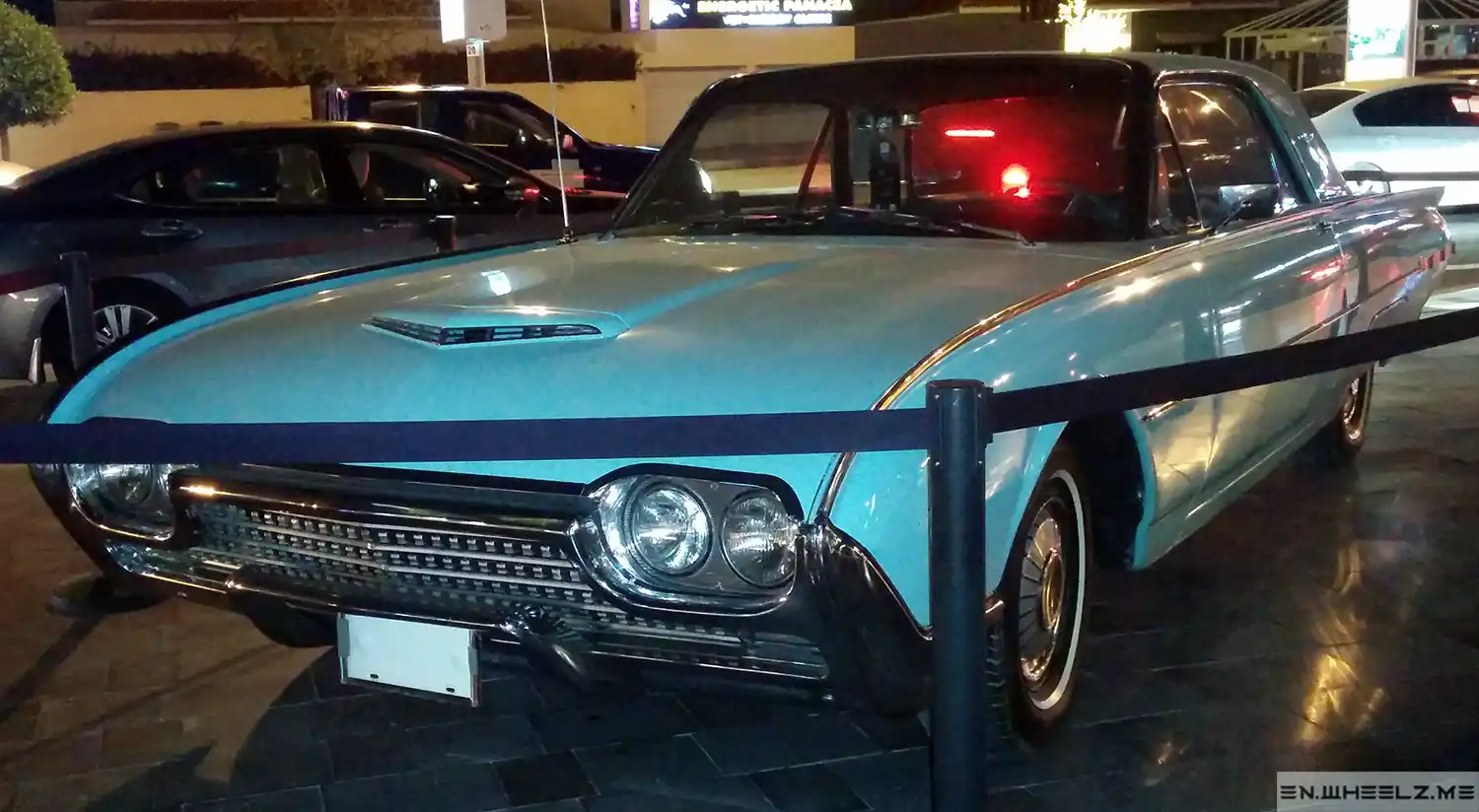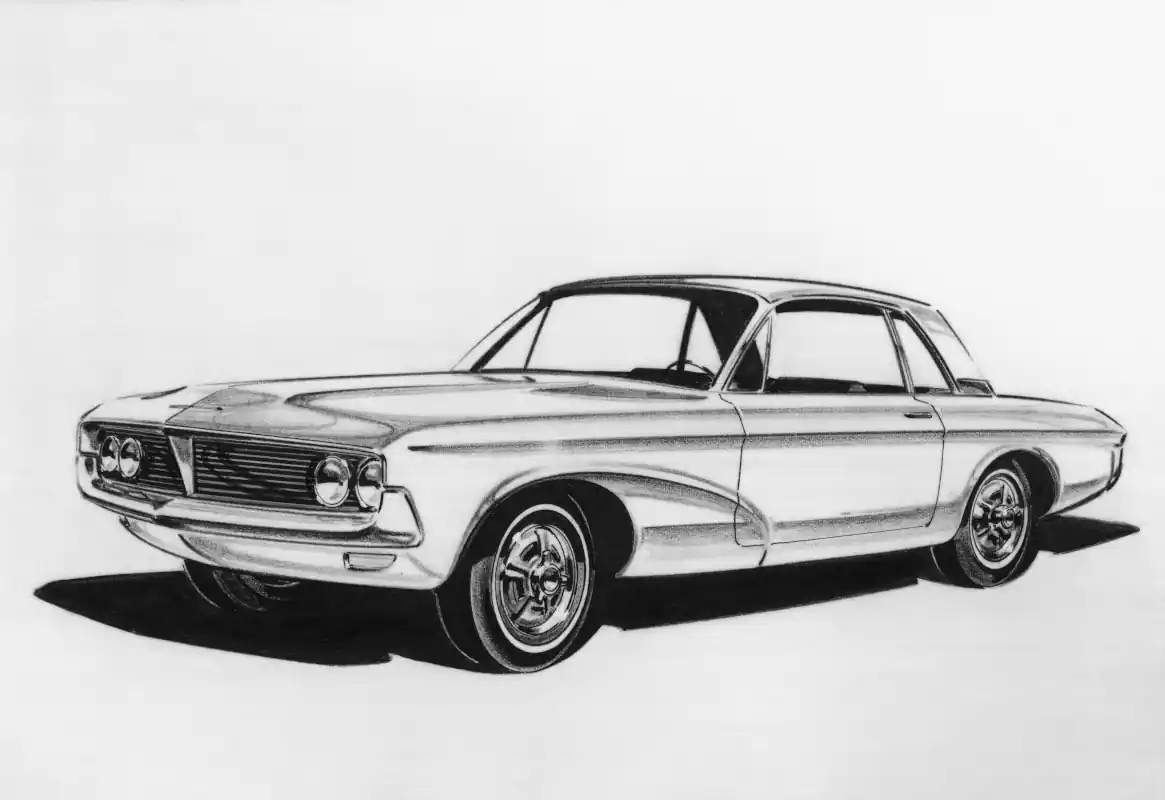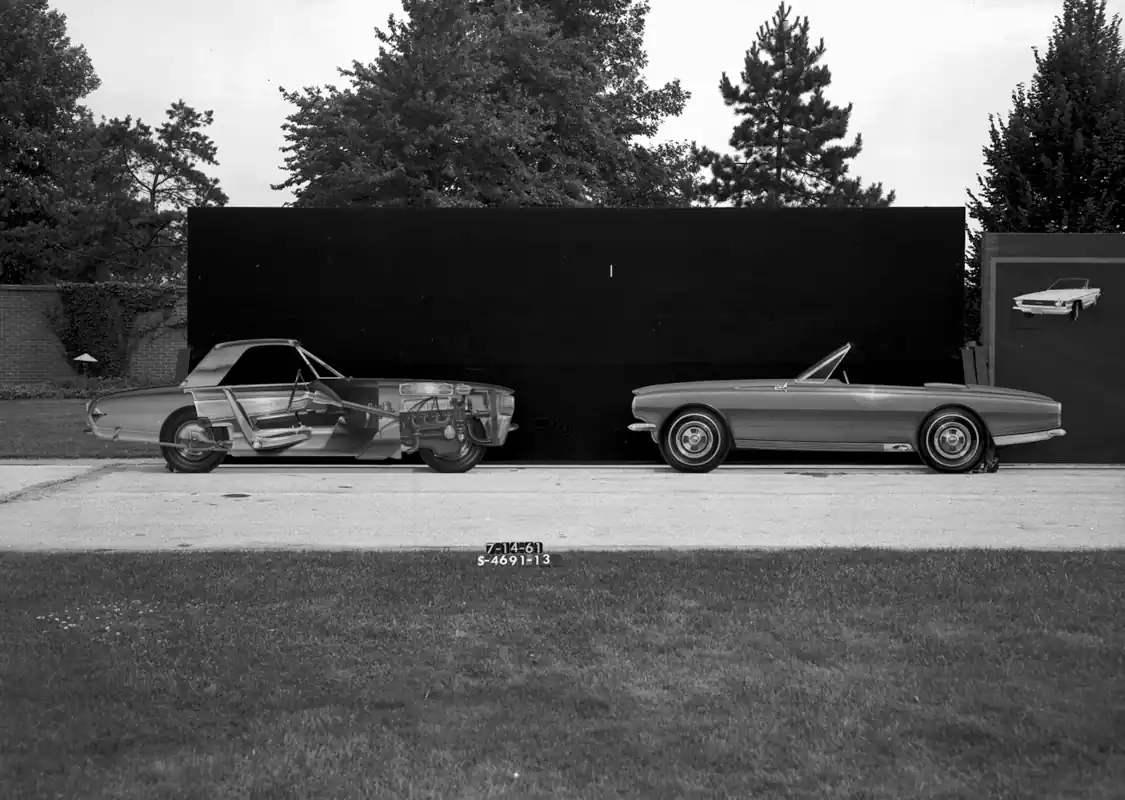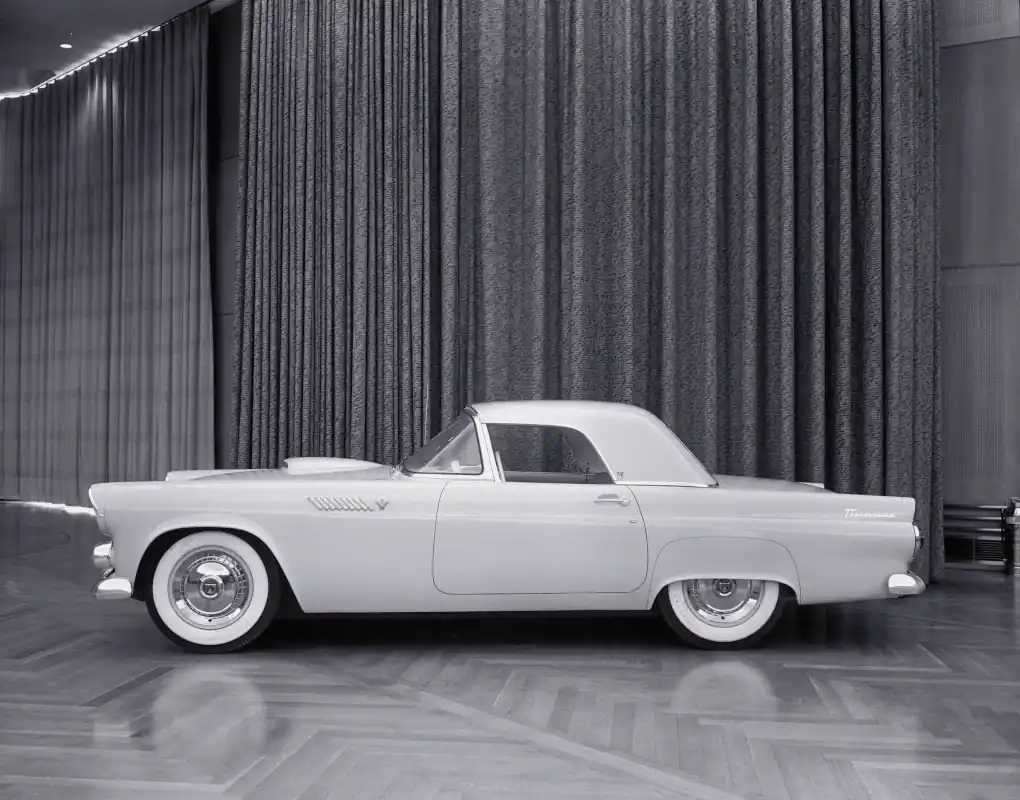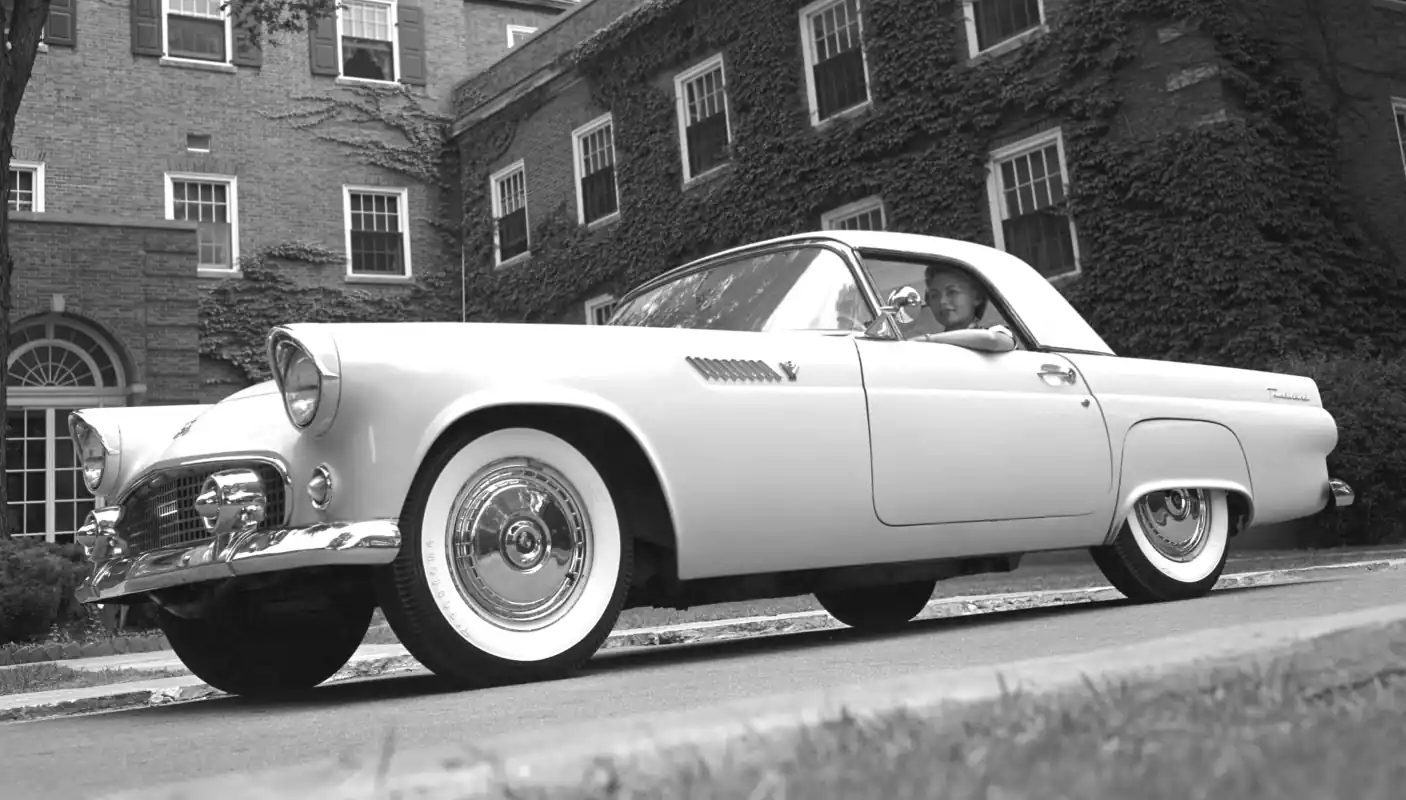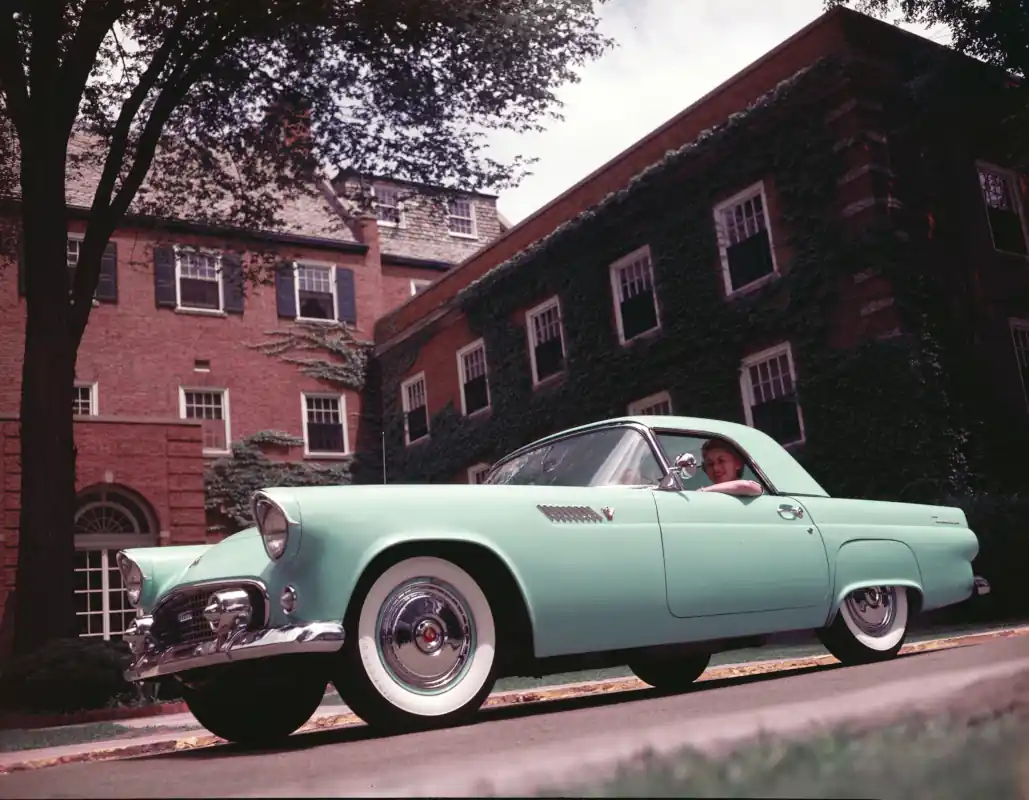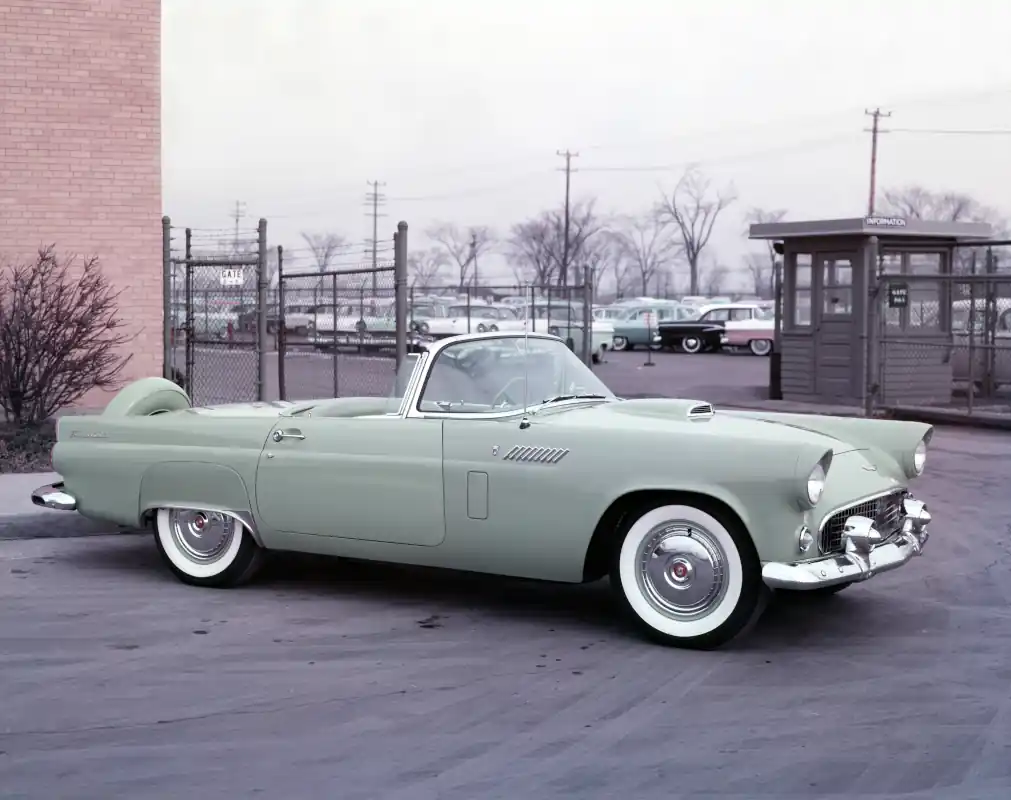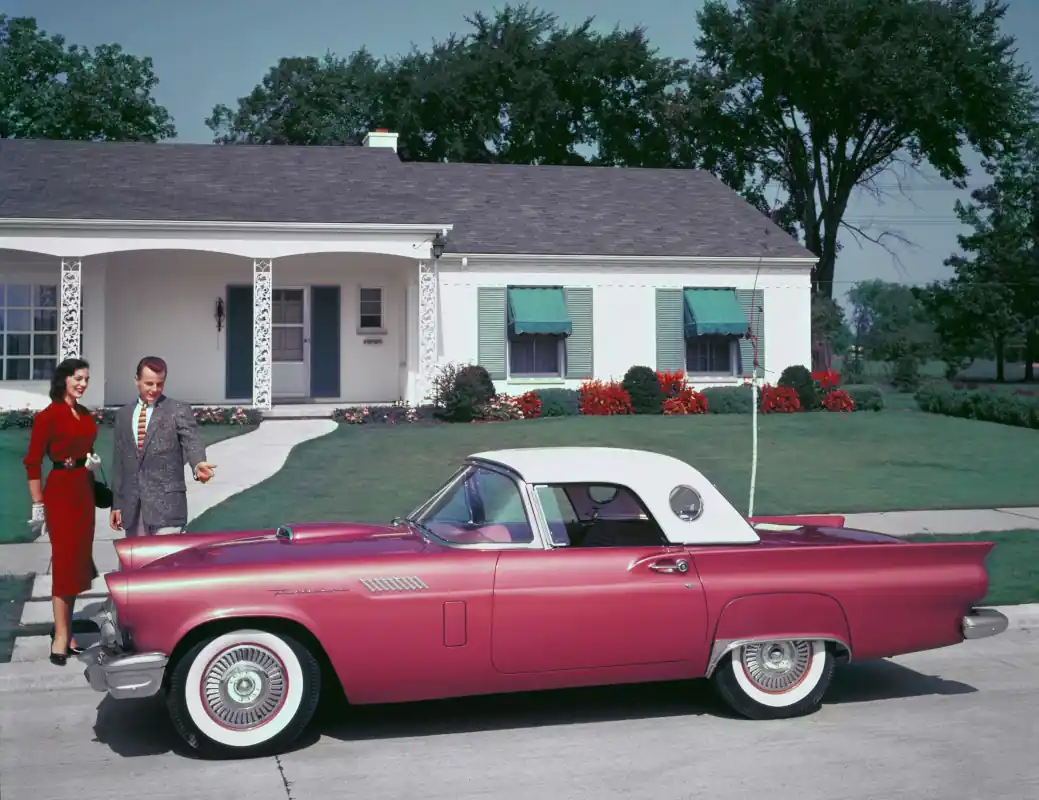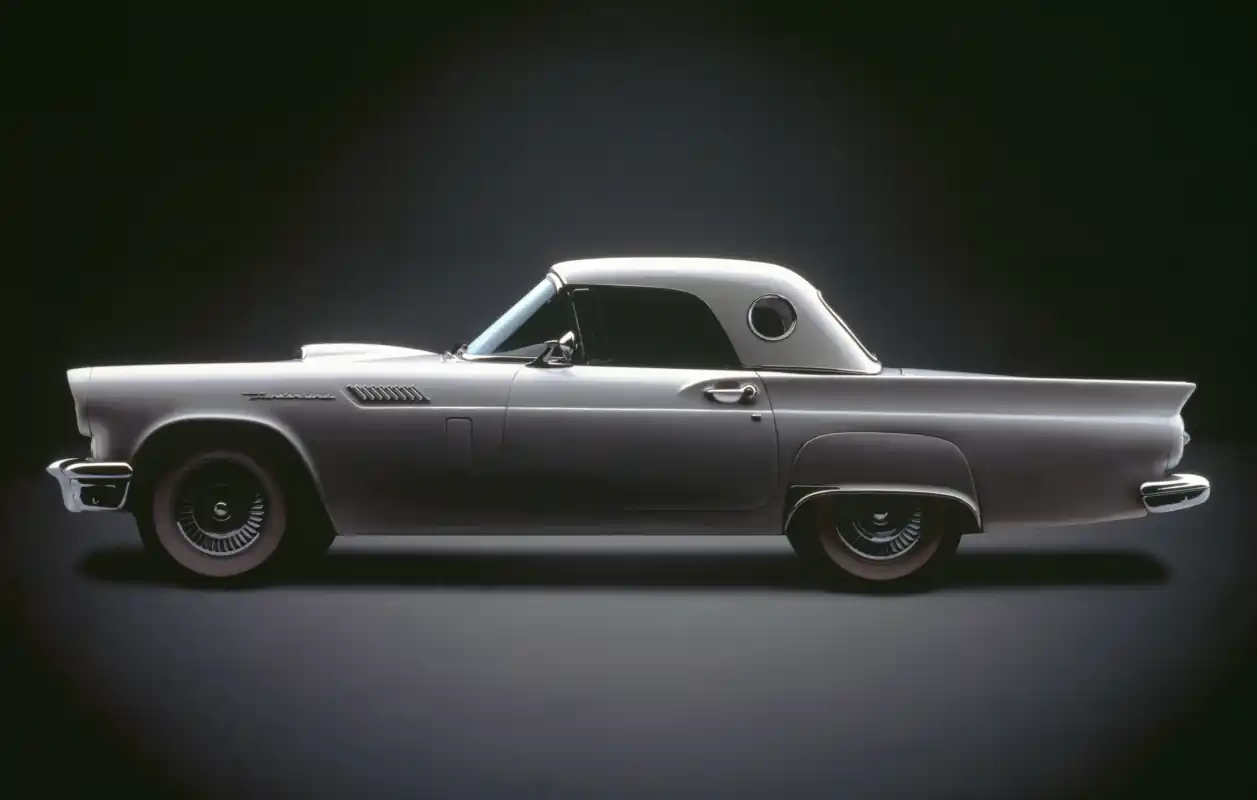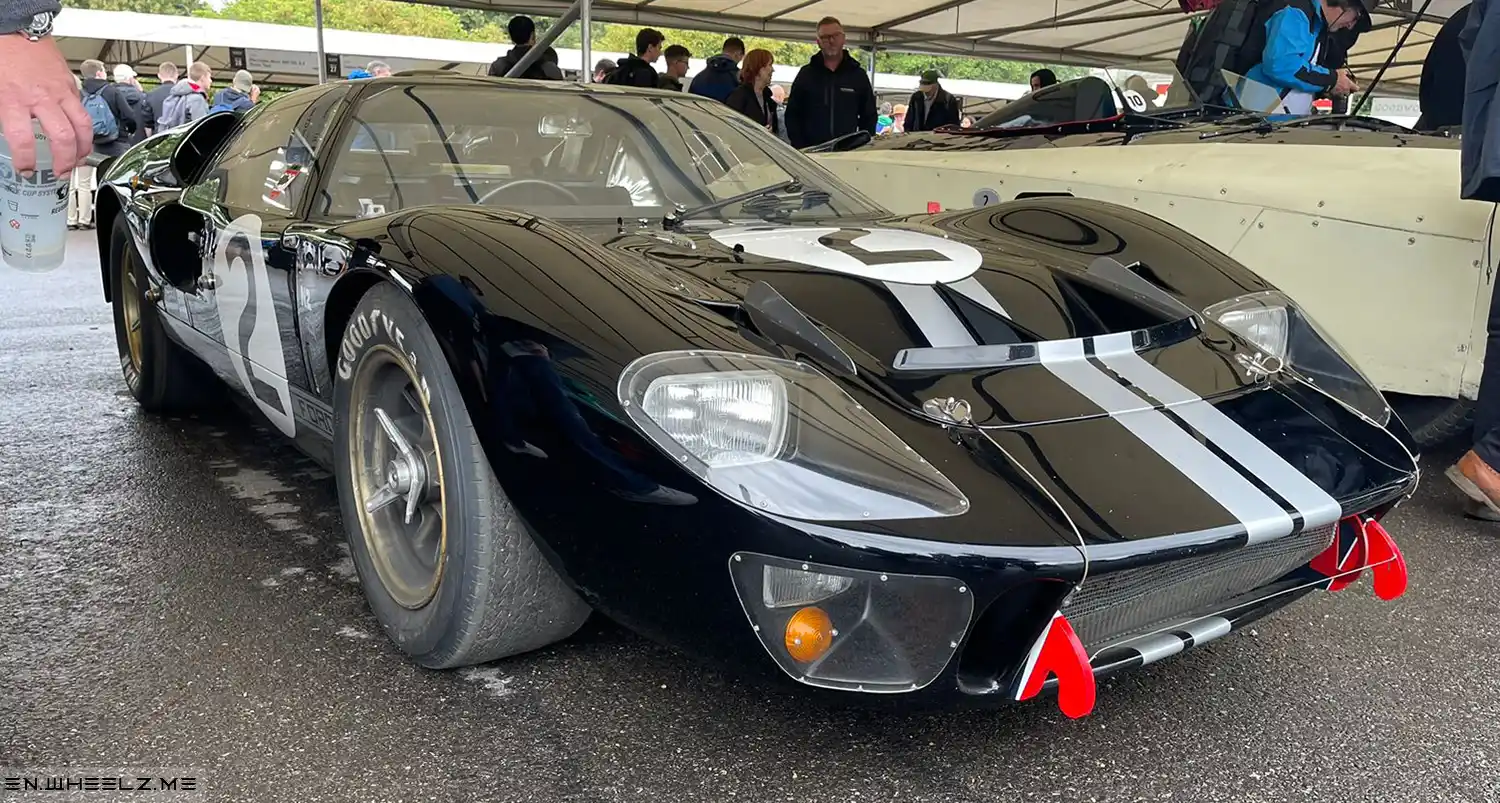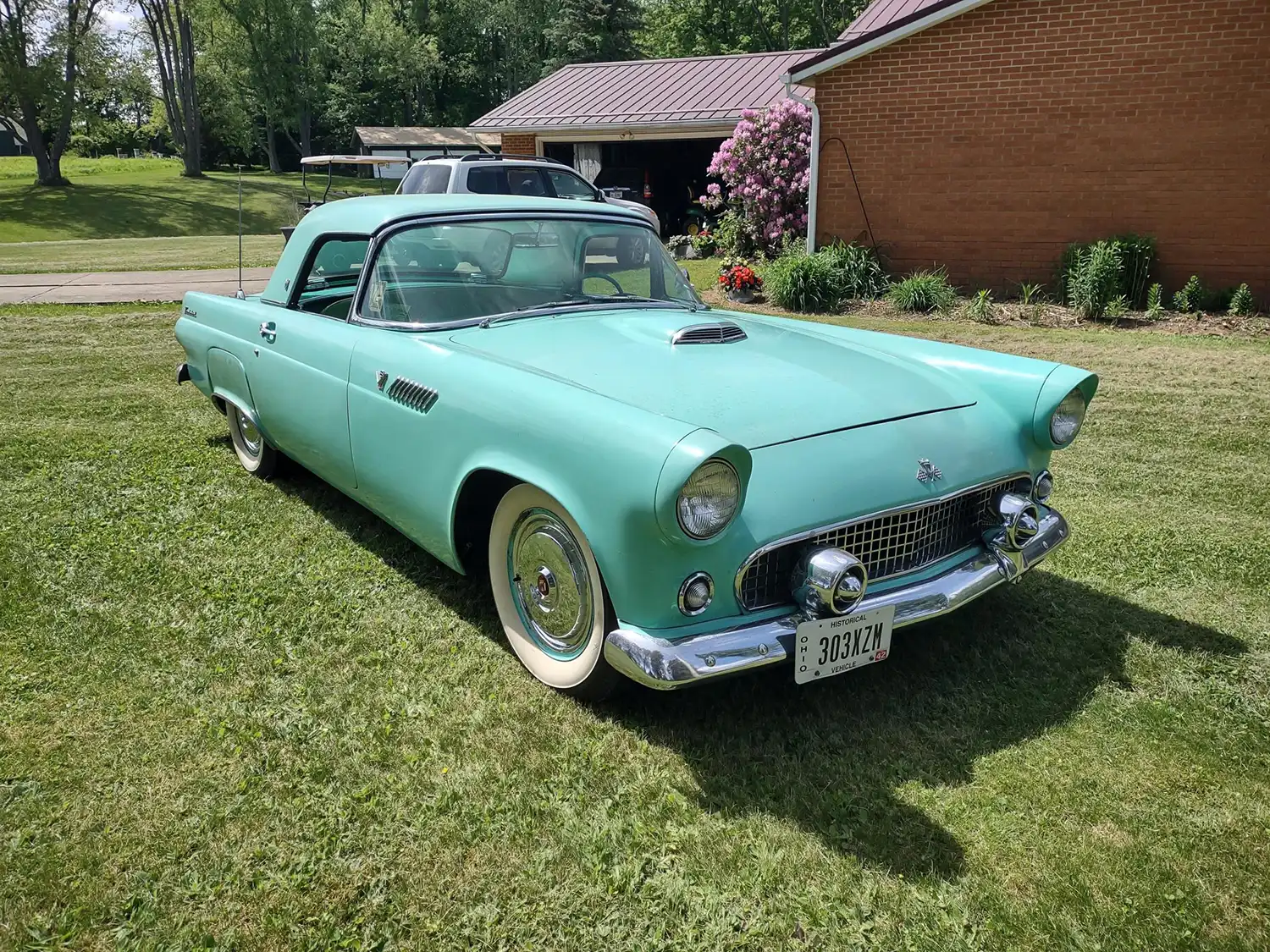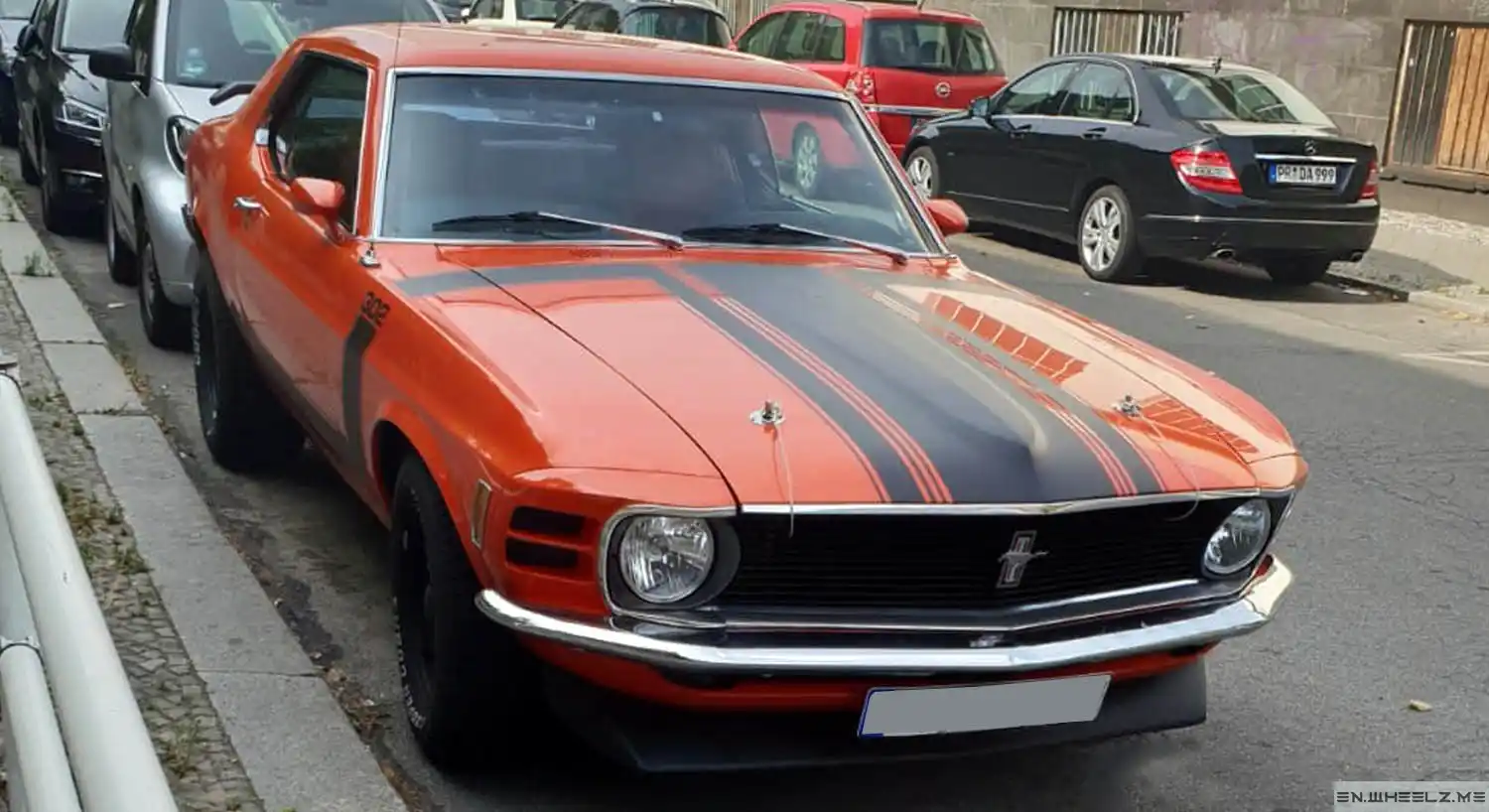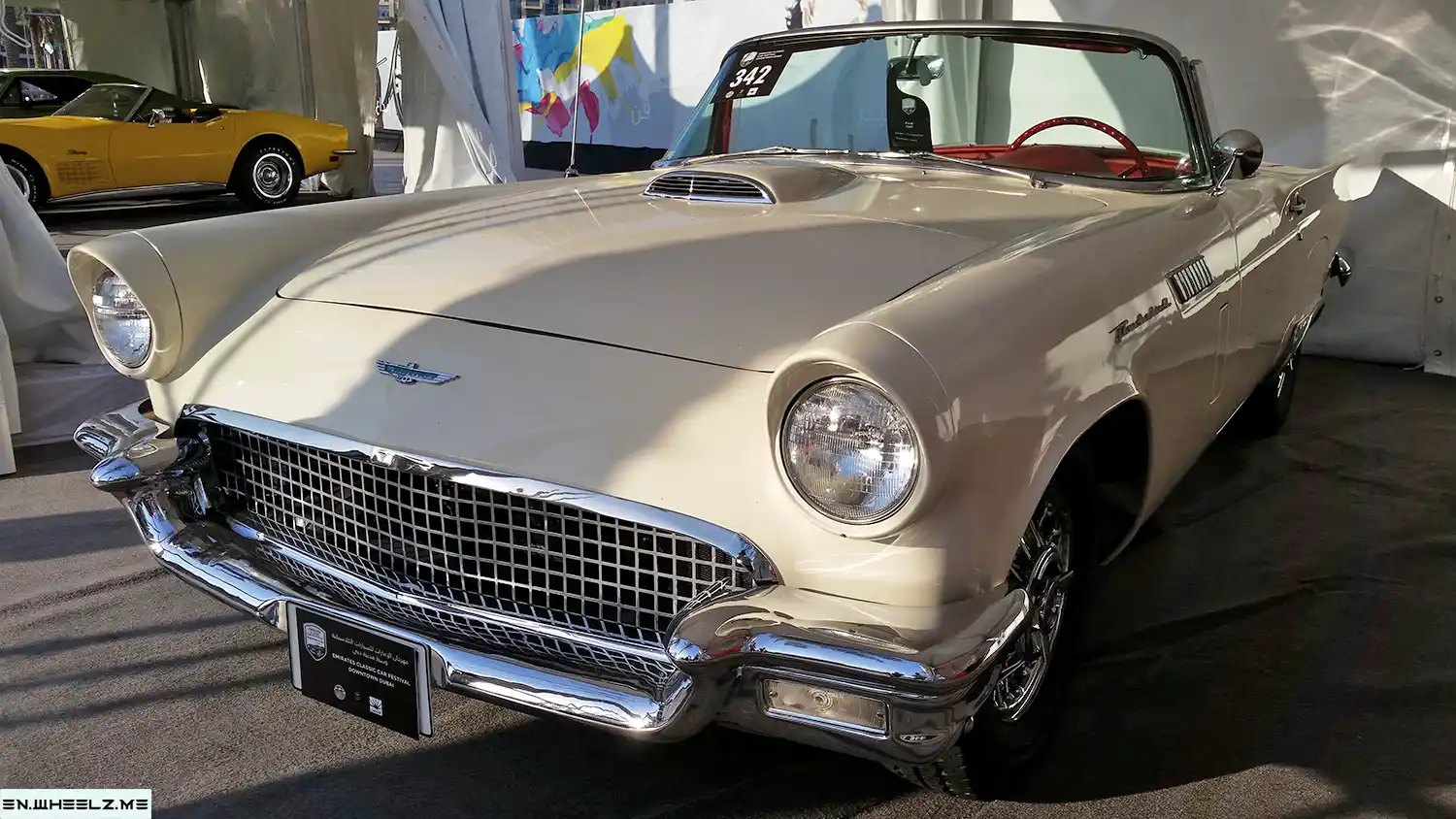
The Ford Thunderbird was the brainchild of two men—George Walker and Louis D. Crusoe. The car was born from the idea that Ford Motor Company should have a sportier vehicle as part of their automobile line. This idea was pursued by the company who decided to pursue a “true Ford sports car” for their 1955 model year.
The initial guidelines called for a two-passenger, canvas-topped open car that would make maximum use of standard production components. The design objectives included a weight of 2,525 pounds, an Interceptor V-8 engine, a balanced weight distribution, acceleration better than the competition, and a top speed of more than 100 miles per hour. The new Ford sports car also was to retain Ford product characteristics and identification to the extent necessary for a ready association with the standard production car.
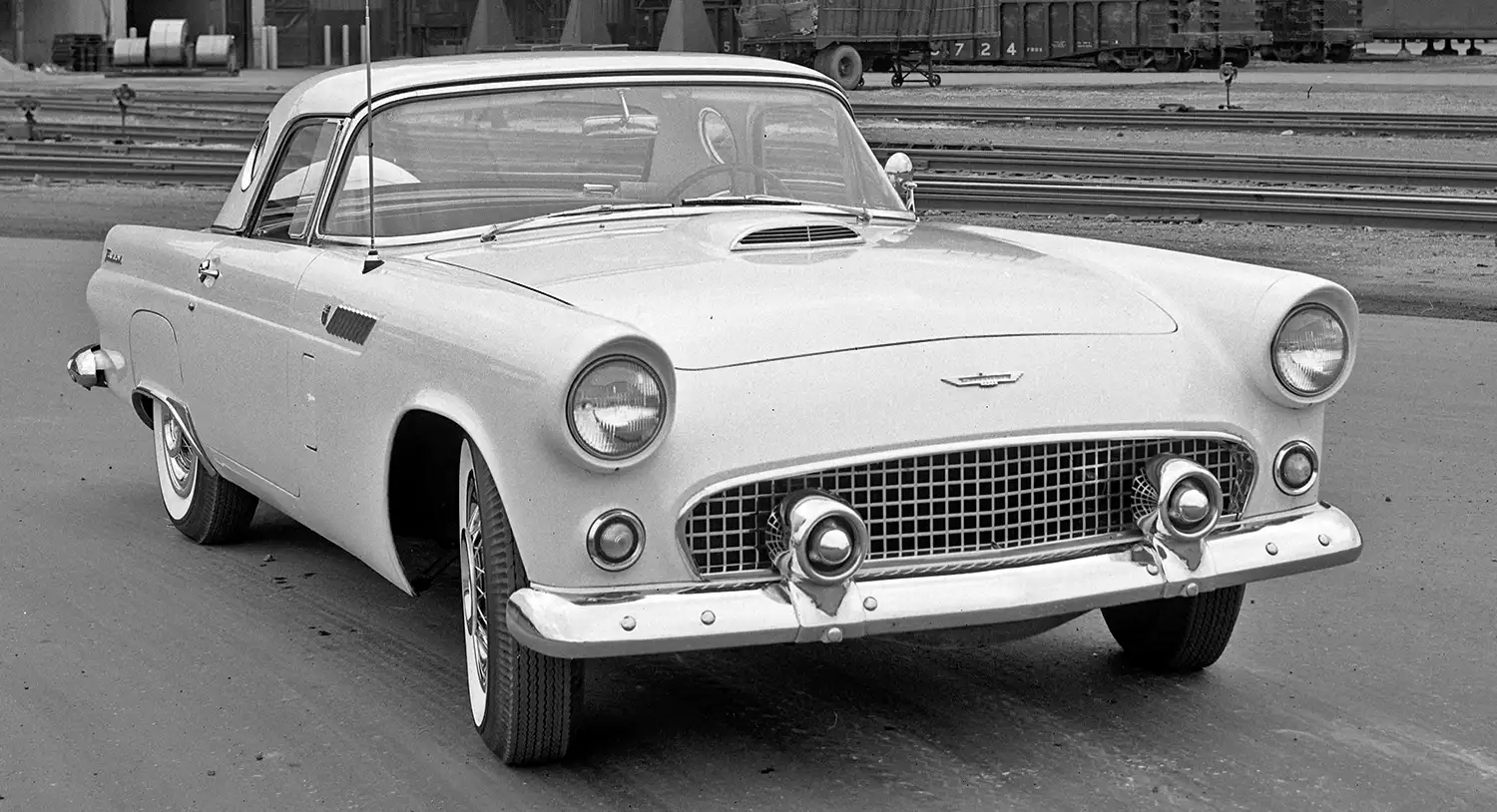
While the production of the car was nearing completion, Ford had a problem—they lacked a name for their new sports car. 5,000 names for the vehicle were suggested including Beaver, Detroiter, Runabout, and Savile. These names were unimpressive to the team working on the sports car. Crusoe offered a $250 suit to anyone who could do better. Ford stylist Alden Giberson stepped up to the challenge and recommended the name that the team would go with—Thunderbird.
The first appearance of the Thunderbird was February 20, 1954 at Detroit’s first post-war auto show. The vehicle featured a more personal than sports car concept with its two-seater feature and build that would allow it to carve its own niche in the existing vehicle market. The first Thunderbird came off the line at the Dearborn Assembly Plant in September of that same year. With a price tag of between $2,695 and $4,000 the vehicle was an immediate hit, with buyers describing the car as a “morale builder that is real fun and sport to drive.”
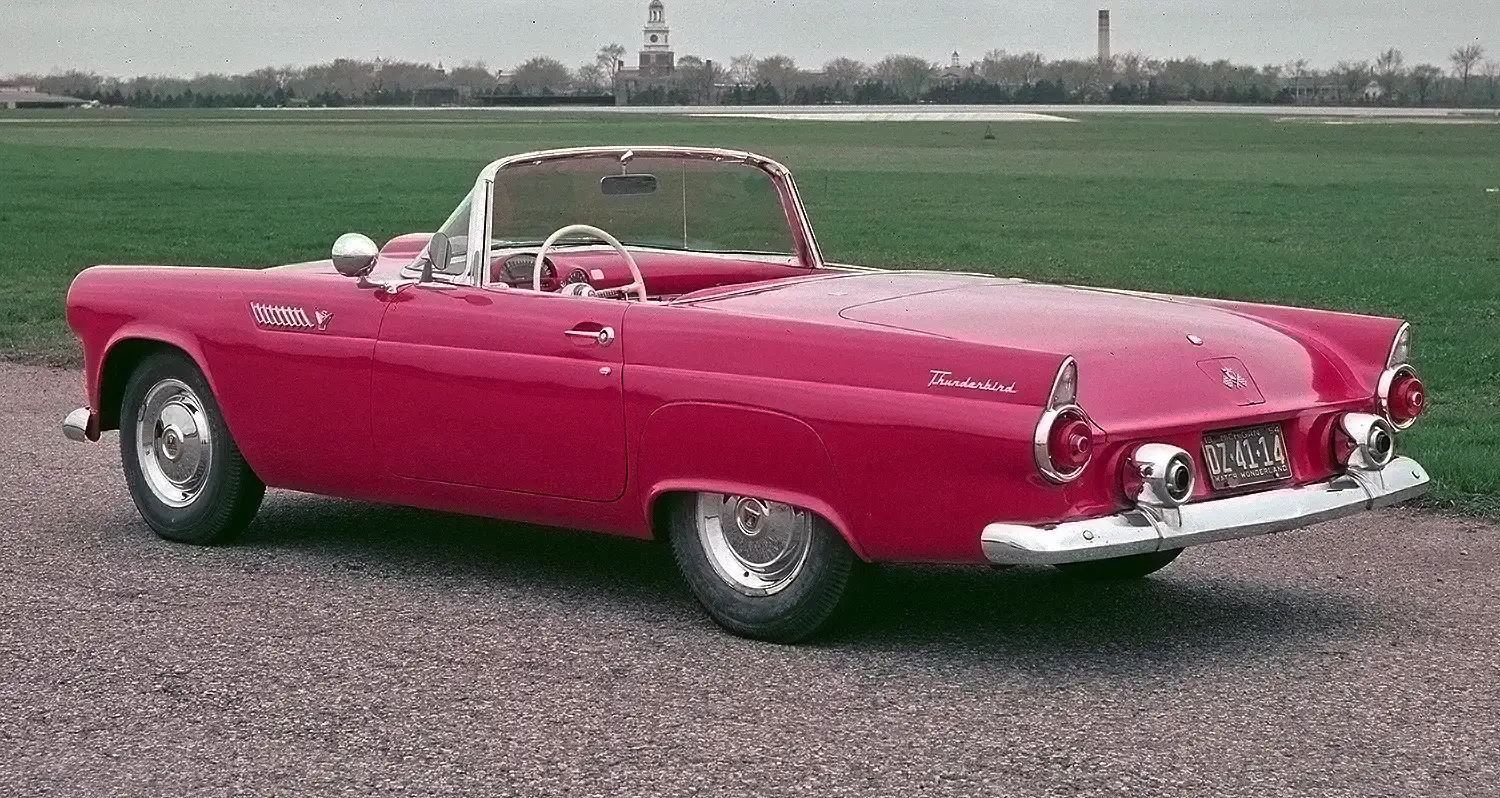
The vehicle would evolve throughout its production time. The changes included increased safety features, adding more engine options, Dial-O-Matic power seats, a radio that automatically adjusted the volume in proportion to the speed of the engine, adding the option of four seats, increasing interior space within the vehicle, a flat line roof, a rear window, and many other features.
The vehicle was also adapted into a special racing package that was used in motorsports. The Thunderbird appeared in NASCAR in 1959 and won six races in the top division that year. The 1982 restyled Thunderbird arrived on the NASCAR scene in that year, and since then won 150 races in NASCAR’s top division, including four wins at the Daytona 500. Additionally, pieces of the Thunderbird were tweaked and used in other performance projects for Ford Motorsports.
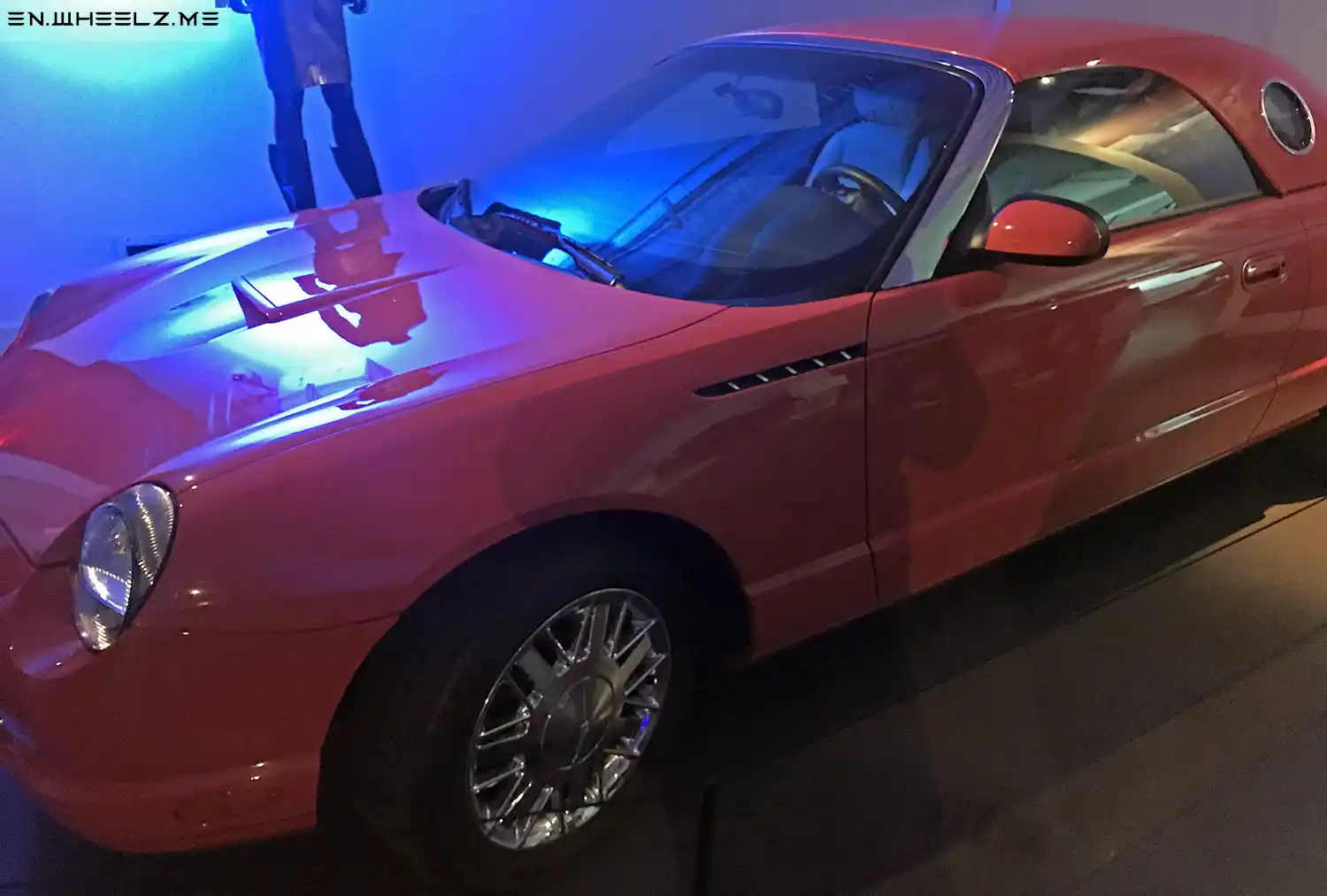
The design of the Thunderbird continued to be fine-tuned and evolved over the decades it was on the market. The Thunderbird ceased production in the mid-1990s, but a Heritage Edition was created in the early 2000s. The vehicle celebrated its 50th anniversary in 2005 despite not being fully produced for fifty years. In that same year, Ford Motor Company announced that the Thunderbird would be discontinued and the nameplate put on hiatus.
Yet the vehicle left a legacy for its speed, agility and then later its luxury and comfort. The Thunderbird or T-Bird was referenced in pop culture regularly showing the cultural significance of the vehicle. The vehicle showed Ford Motor Company’s ability to carve out its own niche and build something unique.
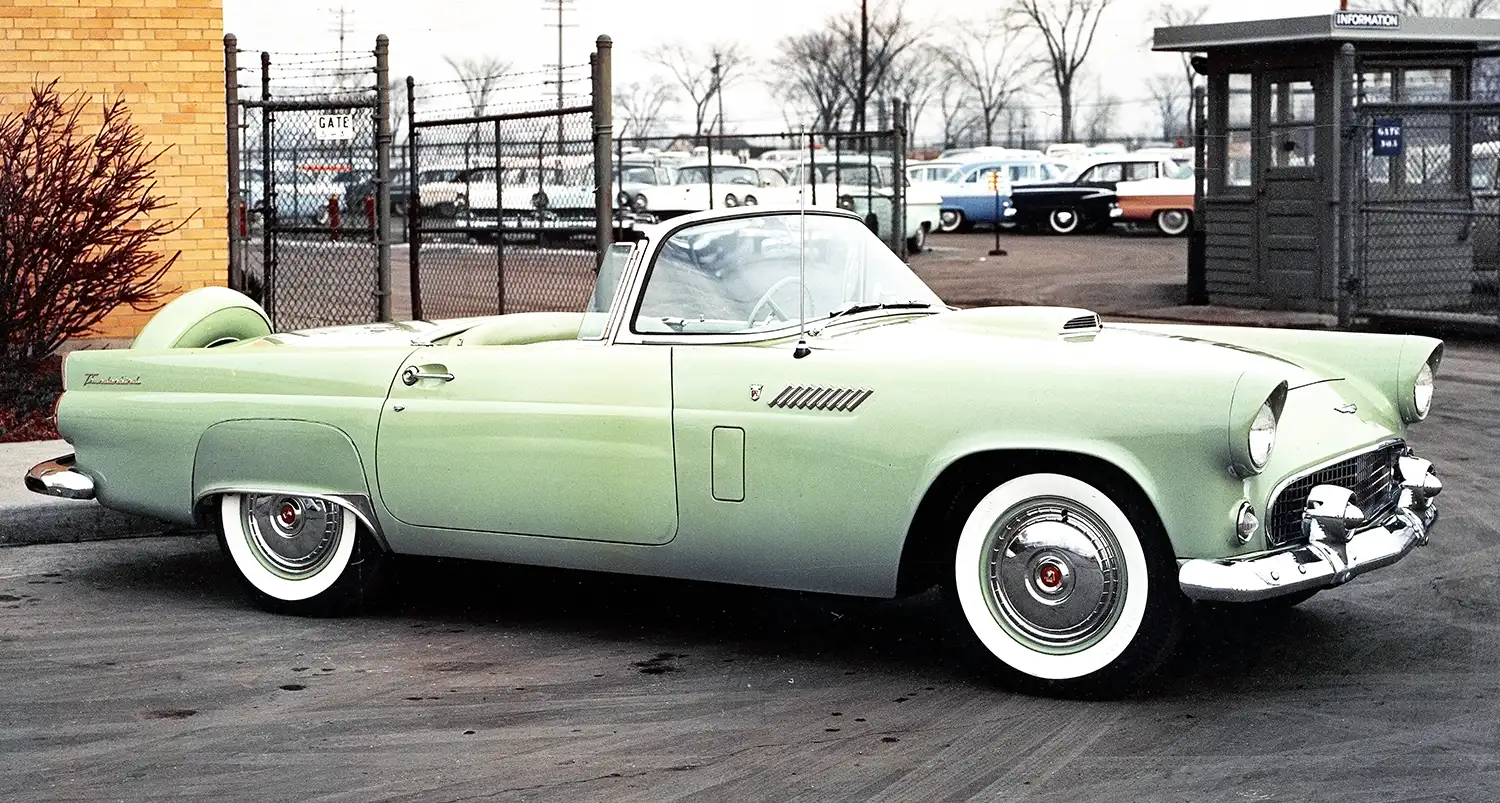
Genesis
Three men are generally credited with creating the original Thunderbird: Lewis D. Crusoe, a retired GM executive lured out of retirement by Henry Ford II; George Walker, chief stylist and a Ford vice-president; and Frank Hershey, a Ford designer. Crusoe and Walker met in France in October 1951. Walking in the Grand Palais in Paris, Crusoe pointed at a sports car and asked Walker, ‘Why can’t we have something like that?’
Walker promptly telephoned Ford’s HQ in Dearborn and told designer Frank Hershey about the idea. Hershey took the idea and began working on the vehicle. The concept was for a two-passenger open car, with a target weight of 2525 lb (1145 kg), an Interceptor V8 engine and a top speed of over 100 mph (160 km/h). Crusoe saw a painted clay model on May 18, 1953, which corresponded closely to the final car; he gave the car the go-ahead in September after comparing it with current European trends.
Unlike the Corvette, the Thunderbird was never a full-blown sporting vehicle; Ford’s description was personal luxury car, and the company essentially created this market segment.
Naming
There was some difficulty in naming the car, with suggestions ranging from the exotic to the ridiculous (Hep Cat, Beaver, Detroiter, Runabout, Arcturus, Savile, El Tigre, and Coronado were submitted among the 5,000 suggestions). One serious suggestion was Whizzer. Crusoe offered a $250 suit to anyone who could come up with a better name.
Stylist Alden “Gib” Giberson submitted Thunderbird as part of a list. Giberson never claimed his prize, settling for a $95 suit and an extra pair of trousers from Saks Fifth Avenue.
According to Palm Springs Life magazine, the car’s final name came not from the Native American symbol as one might expect, but from an ultra-exclusive housing tract in what would later be incorporated as Rancho Mirage, California: Thunderbird Heights.
1955-1957 “Classic Birds” or “Little Birds”
The car was shown at the first postwar Detroit Auto Show on February 20, 1954. The first production car came off the line on September 9, 1954. It went on sale on October 22, 1954) as a 1955 model, and sold briskly; 3,500 orders were placed in the first ten days of sale. Ford had only projected building 10,000; eventual 1955 sales were 16,155.
As standard, the 1955 Thunderbird included a removable fiberglass top; a fabric convertible top was an option, although commonly specified. The only engine option was a 292 Y-block V8. The exhausts exited through twin “bullets” above the rear bumper, as was the fashion.
For the 1956 model, Ford made some changes. To give more trunk space, the spare wheel was mounted outside, Continental-style; the exhausts were moved to the ends of the bumper. Air vents were added behind the front wheels to improve cabin ventilation. To improve rear-quarter visibility with the removable hardtop in place, “porthole” windows were made available as a no-cost option. An optional 312 Y-block V8 was made available for those that wanted more performance.
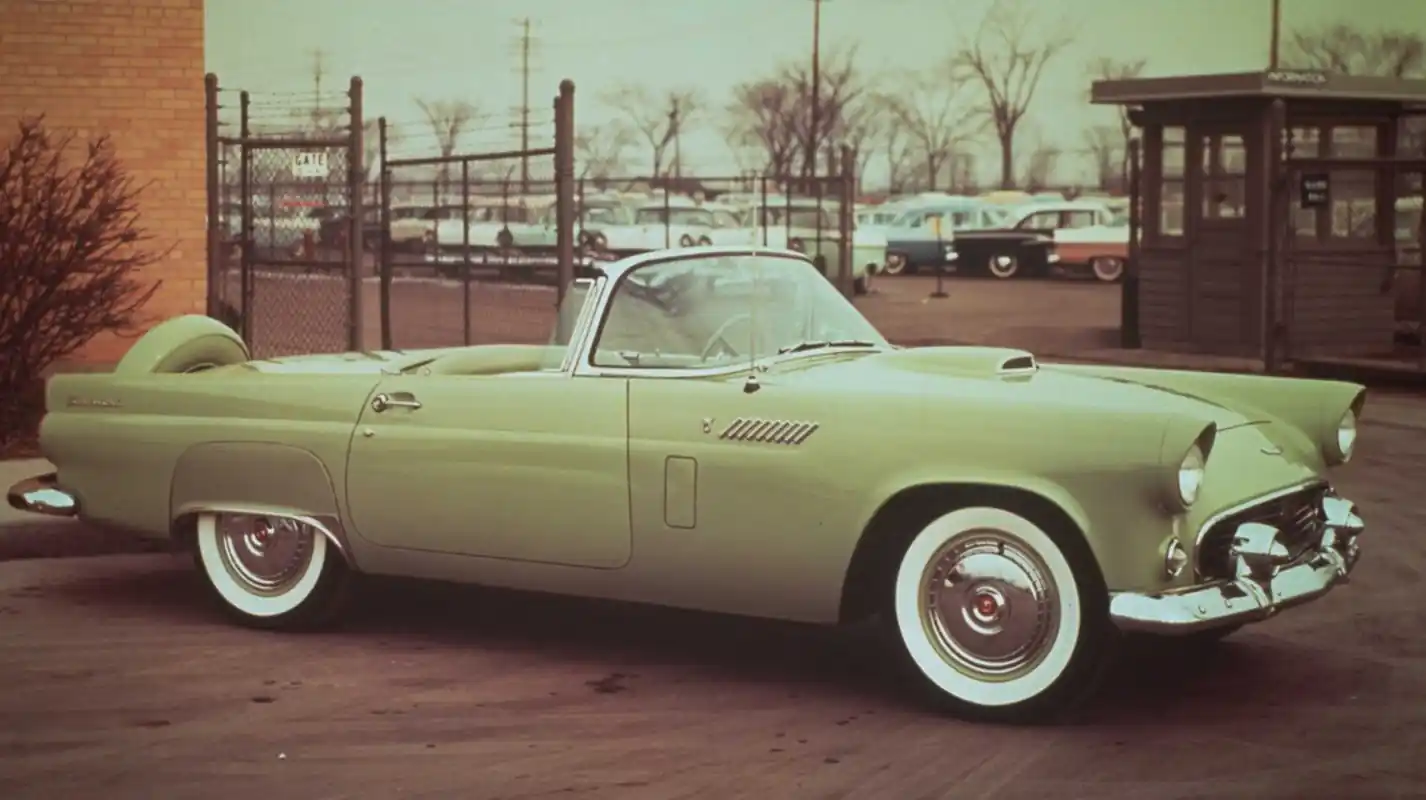
1956 sales were 15,631, the lowest of all three 2-seater Thunderbird model years.
For 1957, a more radical restyle was performed. The front bumper was reshaped, with heavier sides, “bullets” at the ends of the grille, and the section below the grille dropping down. The grille was larger. The tailfins were made larger, more pointed, and canted outward; larger round tail-lights were fitted. The spare wheel moved inside the trunk again, which had been redesigned to allow it to be mounted vertically and take up less space. The side “Thunderbird” script moved from the fins to the front fenders. The styling was so influential, the later British Anglia bore an uncanny resemblance to it. The Corsair was heavily influenced by the later “Bullet bird” of 1961-63.
Engine options increased, because Ford went racing with the Thunderbird that year. As well as the standard 292 and 312 engines, versions of the 312 were produced in higher states of tune, and even a few McCulloch supercharged versions, rated at 300 and 340 hp respectively.
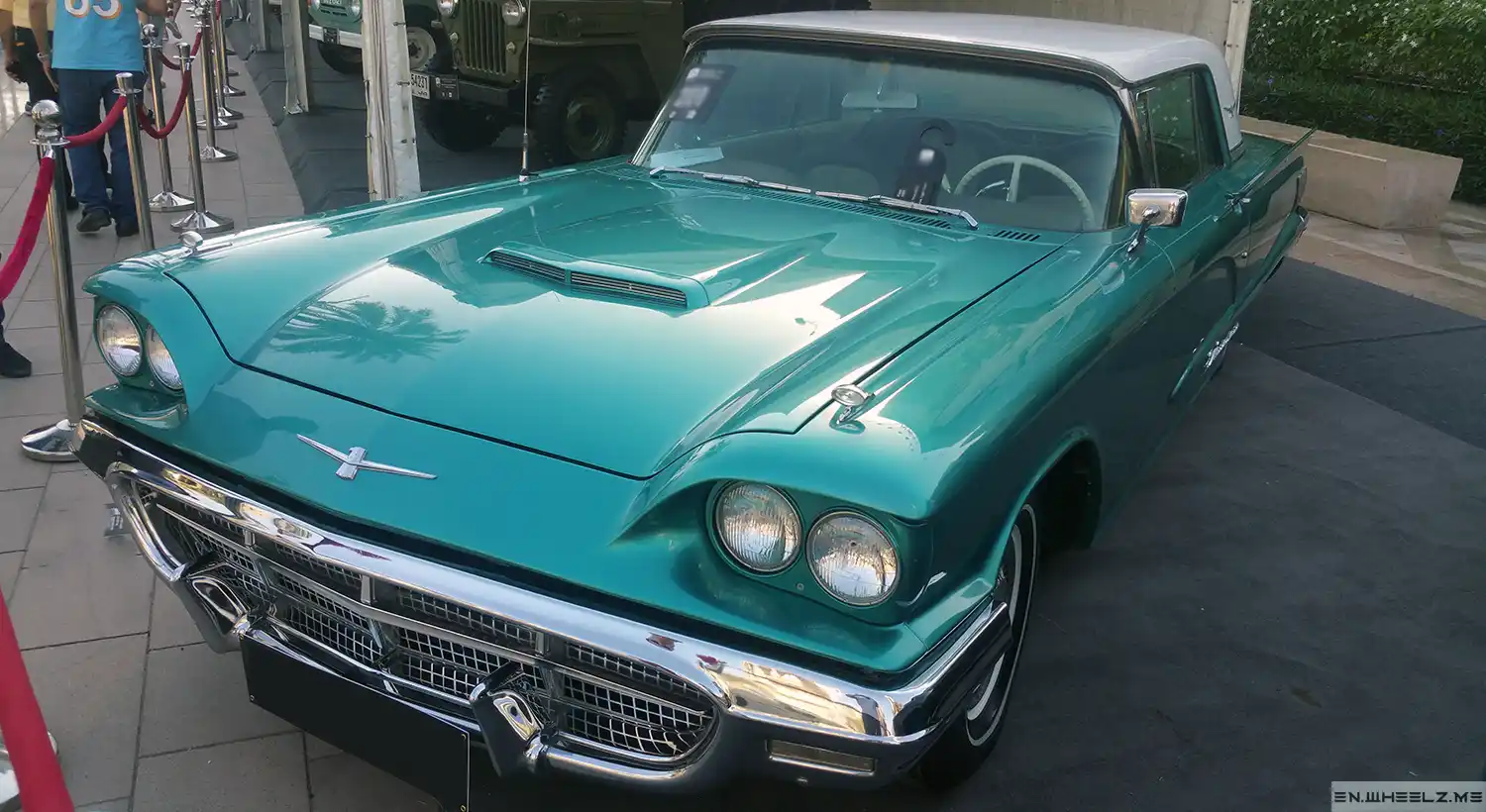
1958-1960 “Square Birds”
Although the original Thunderbird was successful as an image-builder for Ford, the corporation’s executives — particularly Robert McNamara — felt its sales volume was unacceptably small. Market research suggested that sales were inherently limited by its two-seat configuration, making it unsuitable as an only car for families. Therefore, the second generation, introduced for the 1958 model year, was designed as a four-seat car.
The four-seat Thunderbird, like the new Lincolns, was designed with unibody construction, eschewing a separate chassis. The intent was to allow the maximum interior space in a relatively small exterior package. Both the new Thunderbird and the new Lincolns were produced at a new assembly plant at Wixom, Michigan, built as part of a corporate expansion plan to increase the sales of up-market cars (Mercurys, Lincolns, and Thunderbirds).
The new Thunderbird had a distinct new styling theme, sharply angular and formal, but extremely low slung. The look, which was quickly propagated to the rest of Ford’s car line, earned this generation the nickname “Square Bird.” The design was driven entirely by the styling department and approved before the engineering was considered. The design was one of two proposed, styled primarily by Joe Oros, who later worked on the Ford Mustang; the losing proposal, by designer Elwood Engel, was reworked in size to become the 1961 Lincoln Continental.
The new Thunderbird was nine inches (230 mm) lower than the standard American car of the time, at 52.5 in (1.33 m), with only 5.8 in (147 mm) of ground clearance. The significant transmission tunnel intrusion required to fit the powertrain into such a low car was turned into a styling feature by covering it with a large, full-length center console dividing the front and rear seats and containing ashtrays, switches, and minor controls.
Beneath the innovative monocoque construction, the remainder of the engineering was conventional. Ford’s new FE-series engine was used, with 352 in³ (5.8 L) displacement. Standard transmission remained a three-speed manual transmission, with optional overdrive or Cruise-O-Matic three-speed automatic transmission. Front suspension was independent, with coil springs and unequal-length A-arms. The rear was initially a live axle suspended by coil springs, which were intended to be interchangeable with optional air springs that were cancelled before production. Drum brakes were used at all four wheels.
Various delays conspired to have production start only on December 20, 1957, much later than the normal September start; the 1957 Thunderbird was thus built for three extra months.
The new Thunderbird captured Motor Trend’s Car of the Year award in its debut season, the first of three it would eventually accumulate. While many fans of the earlier, two-seat Thunderbirds were not happy with the new direction, Ford was vindicated with sales figures of 37,892, more than double the previous year despite losing three months of production and 1958 being a very poor year for car sales-the Thunderbird was one of only two cars to show a sales increase that year (the other being the Rambler. Only 2,134 convertibles were built, mostly because the convertible model did not become available until June 1958.
For the 1959 model year, Ford made changes to the front, rear, and side ornamentation, and made leather upholstery available for the first time. The rear suspension was revised, discarding coil springs for Hotchkiss drive, with parallel leaf springs. A new engine, the 430 in³ (7.0 L) MEL-series, was available in small numbers. Sales almost doubled again, to 67,456 units, including 10,261 convertibles. Thunderbird advertising in 1959 targeted women in particular, showing glamorous models in country club and other exclusive settings, and the sales figures bore out Ford’s marketing plans.
1960’s sales figures hit another record: 92,843 units sold, including 11,860 convertibles. A rare option in this year was a sunroof; this “Golde Edition” (Golde was a German company whose sunroof patent Ford licensed) sold 2,530 examples.
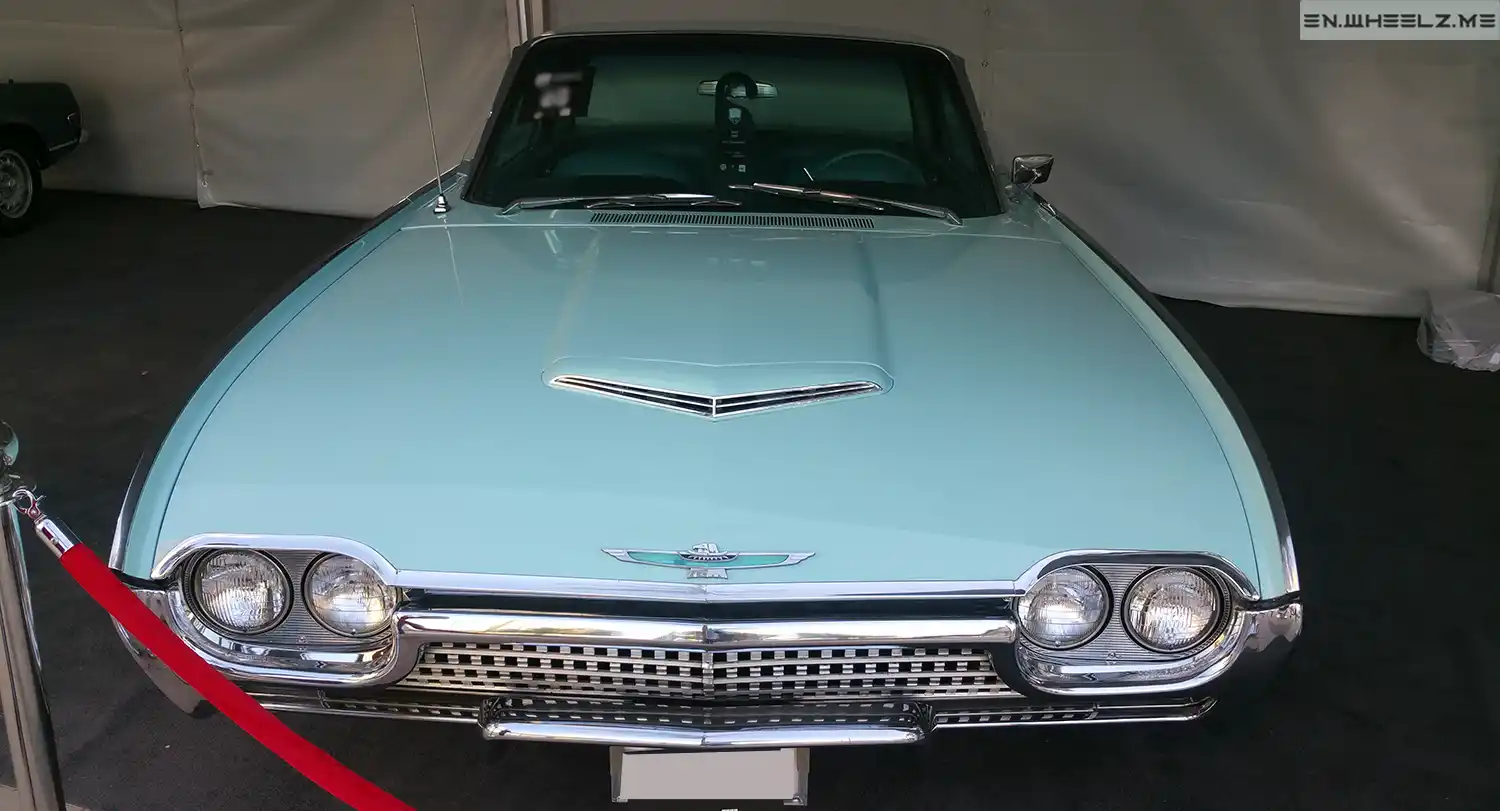
1961-1963 “Bullet Birds”
1961 saw new and much sleeker “Bullet Bird” styling, with a pointed nose and rocket-ship lines, terminating with twin jet exhaust-like round taillights with fins above. Sales were strong, if not quite up to record-breaking 1960, at 73,051 including 10,516 convertibles. A new, larger 390 in³ (6.4 L) FE-series V8 was the only engine available. The Thunderbird was 1961’s Indianapolis 500 pace car, and featured prominently in US President John F. Kennedy’s inaugural parade, probably helped along by the appointment of Ford executive Robert McNamara as Secretary of Defense.
1962 saw strong production figures of 78,011 (including 9,884 convertibles) and the introduction of the Thunderbird Sports Roadster. This model included a tonneau cover that covered the rear seat area, effectively transforming the car into a two-seater model, as well as Kelsey-Hayes wire wheels and special trim. Despite its appealing appearance, which earned a number of high-profile sales, including the model owned by Elvis Presley, its impracticality and high price led to poor sales. The tonneau cover was available through the 1964 model year, but few were sold.
Also introduced in 1962 was the Landau model, with a vinyl roof and simulated S-bars on the rear pillars. This was the beginning of the 1960s/1970s fashion for vinyl roof treatments, and a vinyl roof was a popular Thunderbird feature for the next twenty years.
1963’s numbers were down at 63,313. The Landau became the number 2 model after the standard hardtop, at 12,193 sold, while a Limited Edition “Principality of Monaco” Landau model, personalized with a plaque displaying the owner’s name and the car’s limited production number, were limited to and sold 2,000 units. They all came with special white leather interior and a rose colored vinyl padded roof with Landau irons. Only 5,913 convertibles and 455 Sports Roadsters sold, indicating a decline in convertible popularity at the time.
1964-1966 “Flair Birds”
For 1964 the Thunderbird was restyled yet again, discarding some of the rocket-ship styling cues of the previous generation in favor of a more squared-off, “formal” look. Dimensions changed only fractionally, and the suspension, engine, and transmission remained as before, but continued efforts to minimize noise and vibration from the unit body led to a weight increase of some 244 lb (110 kg).
The Thunderbird’s sporty image had by that time become only an image. The standard 390 cu. in. 315 bhp engine needed nearly 11 seconds to push the heavy T-bird to 60 mph (96 km/h), although with enough room a top speed of about 120 mph (200 km/h) was obtainable. The softly sprung suspension allowed considerable body lean, wallow, and float except on smoothly surfaced highways; there was an export suspension package available as special order. Contemporary testers felt that the Buick Riviera and Pontiac Grand Prix were substantially more roadable cars, but the Thunderbird remained the leader of the market segment.
The revised ‘bird was initially offered as a hardtop, a convertible, or Landau, with vinyl roof and simulated landau irons. The tonneau cover and wire wheels of the Sports Roadster remained available as a dealer-installed option, although only 50 were sold. Total 1964 sales were excellent: 92,465, up nearly 50% from the previous year.
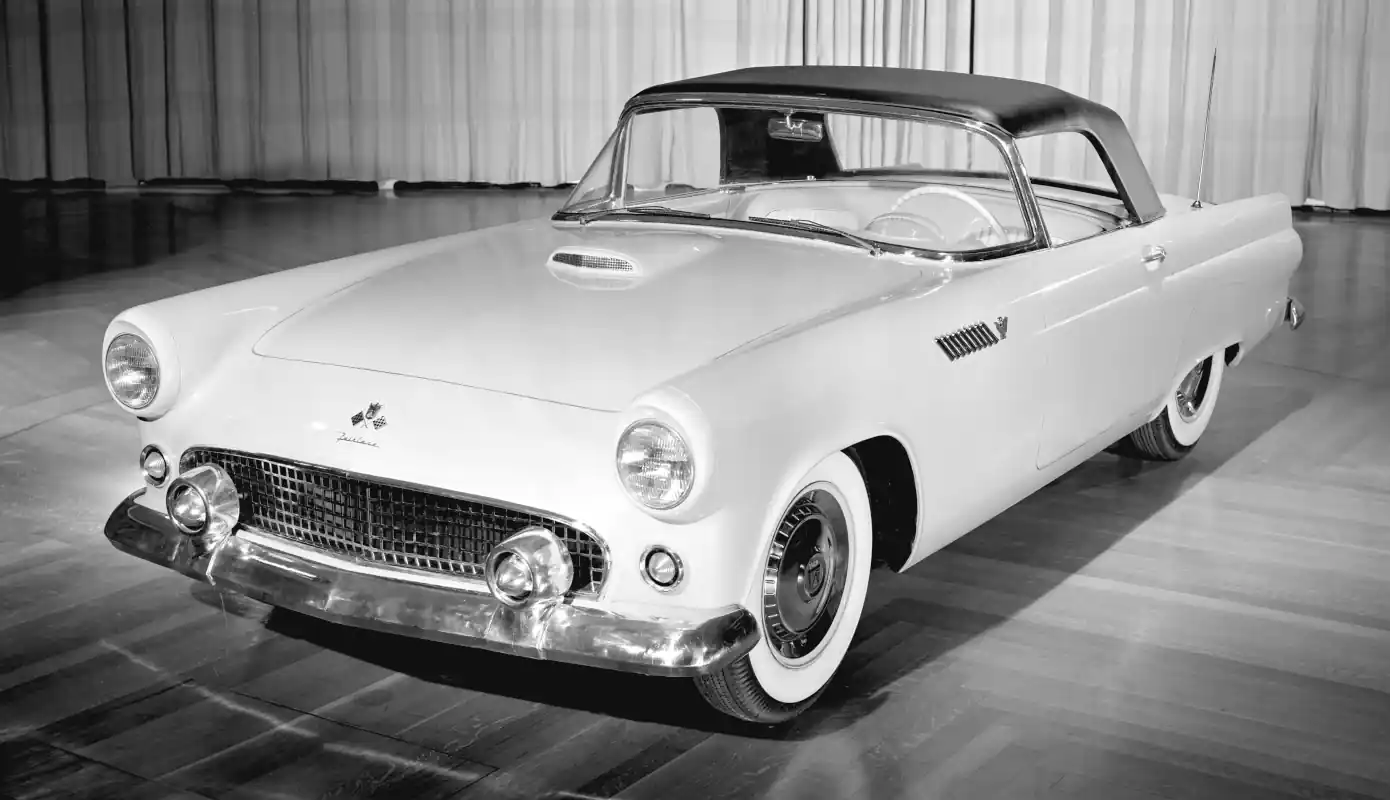
Several features intended for the new generation were delayed until 1965, when front disc brakes became standard equipment and sequential turn signals were added. The latter feature flashed the individual segments of the broad, horizontal tail lights in sequences from inside to outside to indicate a turn. The delay resulted from legal difficulties with various U.S. state laws on vehicle lighting. Sales, impacted by increasing competition (including from Ford’s own Mustang), dipped to 74,972.
For 1966 the larger, 428 cu. in. (7.0 L) V-8 became optional, rated at 345 gross horsepower (257.4 kW) and providing a notable improvement in 0-60 acceleration (to about 9 seconds). A new Town Hardtop model was offered, featured a roof with blind quarter panels for a more ‘formal’ look (at the cost of rear visibility). The Landau model was replaced by the Town Landau, which retained the previous model’s padded roof and landau S-bars, but applied them to the Town Hardtop’s formal roof. The Town Landau was by far the best-selling model, accounting for 35,105 of the 1966 model’s 69,176 sales.
There was a very rare special order 427 available through certain ford dealers for 1963-1965 Thunderbirds, 120 of these ‘high performance’ T-birds were made. Only 6 are still known to exist today. See a 427 tbird at http://www.cardomain.com/ride/2080960. It is documented that Bob Tasca a well known drag racer of the 60’s ordered a factory fitted 427 1964 T-bird that was said to do 0-60 mph in 6 seconds flat with a top speed of 135 mph.
A “Flair ‘Bird” later had a major role in the TV series Highlander as protagonist Duncan Macleod’s main mode of transportation.
A green 1966 Thunderbird convertible was prominently featured in the 1991 film Thelma & Louise, starring Susan Sarandon and Geena Davis, and directed by Ridley Scott.
1967-1971 “Glamor Birds”
This fifth generation saw the second major change of direction for the Thunderbird. Having moved from being a two-seater quasi-sports car in 1955-1957 to a four-seater personal luxury car in 1958, the Thunderbird had fundamentally remained the same in concept through 1966, even though the styling had been updated twice. The introduction of the Ford Mustang in early 1964 (as a 1965 model) had, however, challenged the Thunderbird’s market positioning. It, like the Thunderbird, was a small, two-door, four-seater with sporting pretensions, but it was substantially cheaper. The Thunderbird’s sales suffered. Ford’s response was to move the Thunderbird upmarket, while some fans of the classic Thunderbird consider 1966 to be the last year of interest.
For 1967 the Thunderbird would be a larger car, moving it closer to Lincoln as the company chose to emphasise the “luxury” part of the “personal luxury car” designation. Other companies had already done the same; the Buick Riviera, in particular.
Mindful of the company’s problematic experiences with the 1958 Lincolns, Ford chose to abandon the Thunderbird’s traditional unibody construction for this larger car, turning to a body-on-frame method with sophisticated rubber mountings between the two to reduce vibration and noise.
The convertible, increasingly a slow seller, was dropped. Instead, the company introduced something new to the market segment; a four-door model (“Fordor” in Ford parlance). Perhaps to emphasise the Thunderbird’s closer ties to the Lincoln marque as it moved upmarket, the rear doors were backward-opening suicide doors as on the 1960s Lincoln Continental. The four-door would remain available through 1971 but never generated substantial sales.
The new 1968 Lincoln Continental Mark III was based on the four-door Thunderbird chassis, and from that point until the late Nineties, Thunderbirds and Continental Marks were generally related cars, the Thunderbird following the Mark’s growth to enormity in the 1972 model year. The Mercury Cougar also often shared components.
Styling
The 1967 styling would be radically different from what came before. Ford’s stylists delivered a radical shape that in many ways anticipated the styling trends of the next five years. A gaping wide “fishmouth” front grille that incorporated hidden headlights was the most obvious new feature. The look was clearly influenced by the intakes on jet fighters such as the F-100 Super Sabre, and was enhanced by the flush-fitting front bumper incorporating the bottom “lip” of the “mouth”.
The sides were the barrel-like “fuselage” style that became so popular during this period. The belt line kicked up “coke-bottle” style after the rear windows, again a styling trait that would prove ubiquitous. Large C-pillars (and a small “formal” rear window on the 4-door) meant poor rear visibility but were the fashion of the time.
The taillights spanned the full width of the car, and featured, as in previous Thunderbird models, sequential turn signals.
In 1971, Neiman Marcus offered “his and hers” Thunderbirds in its catalog, with telephones, tape recorders and other niceties. They retailed for $25,000 for the pair.
Sources: Ford & Wikipedia (GNU Free Documentation License)
